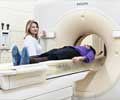- Using a computer-aided technology called augmented reality in operation theaters may aid and improve the outcome of similar surgeries.
- HoloLens, a wearable headset system allows surgeons to visualize the internal structure of the limb by overlaying a 3D model onto the limb.
- The approach helps surgeons locate and reconnect key blood vessels during reconstructive surgery with more precision.
"We are one of the first groups in the world to use the HoloLens successfully in the operating theatre," said Dr Philip Pratt, a Research Fellow in the Department of Surgery Cancer and lead author of the study, "Through this initial series of patient cases we have shown that the technology is practical, and that it can provide a benefit to the surgical team. With the HoloLens, you look at the leg and essentially see inside of it. You see the bones, the course of the blood vessels, and can identify exactly where the targets are located."
Building the model
Patients undergoing surgery are first scanned. The CT of their limbs maps the structure of the limb including the position of the bones and blood vessels. The scanned images are then segmented into bone, muscle, fatty tissue and blood vessels by a radiologist. These are then loaded onto a software to generate a 3-dimensional model. Once a model is generated, the data was fed into a specially designed software that provides images for the HoloLens headset. When the surgeon looks at the patient’s limb through the HoloLens, the generated model overlays the actual limb giving the surgeon the precise location of the internal complexity. If needed, the models may be manipulated through hand gestures to make any fine adjustments and correctly line up the model with surgical landmarks on the patient's limbs, such as the knee joint or ankle bone.Dr. Dimitri Amiras, a consultant radiologist at Imperial College Healthcare NHS Trust, said, "Now, using the HoloLens, we can identify where the blood vessels are in 3D space and use virtual 3D arrows to guide the surgeon. Currently, data preparation is a time-consuming process, but in the future, much of this could be automated, with the consultant radiologist checking the accuracy of the model against the original scan. I think this is a great example of what can be achieved in an Academic Health Science Centre."
Limitations
- Possible errors in the modeling stage
- Overlaid model may be misaligned with the actual limb
- Since the trial was only conducted on limbs that have surgical landmarks like ankles and knees, this does not apply to body parts like the abdomen
- Pratt, P. et al. Through the HoloLens™ looking glass: augmented reality for extremity reconstruction surgery using 3D vascular models with perforating vessels. European Radiology Experimental2, (2018).
Source-Medindia













